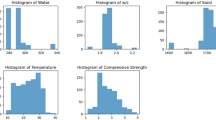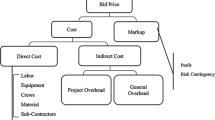Abstract
The current study combines three techniques: multi-linear regression (MLR), artificial neural networks (ANN) and support vector machine (SVM) to introduce a novel, alternative approach to using artificial intelligence techniques for earned value management of the construction projects in the Republic of Iraq. The proposed strategies are used to create mathematical models for calculating the Schedule Performance Index (SPI), Cost Performance Index (CPI) and to complete cost performance indicator (TCPI) in residential projects both before and during construction. The MLR technique was used to identify the impact parameters using the statistical package for the social sciences program as well as a web-based software designed to perform the estimating calculations quickly, accurately and without much effort. Besides, the ANN technique was used in the Neuframe software to create new prediction models using the backpropagation algorithm. The SVM is the third technique utilized in the creation of prediction models, whereby the SMOreg algorithm is employed in the WEKA program. In terms of MLR, the values of average accuracy (AA%) were determined to be 95.89%, 96.89% and 95.91% while those of R were 92.911%, 98.916% and 97.837% for each of SPI, CPI and TCPI accordingly. The AA% results of the ANN approach were 83.09%, 90.83% and 82.88%, and the correlation coefficient (R) results were 91.95%, 93.00% and 92.30% for SPI, CPI and TCPI, respectively. Furthermore, SVM findings reveal that the AA% is equal to 94.12%, 71.76% and 84.82% and the correlation coefficient (R) is equal to 99.56%, 91.744% and 99.71% for SPI, CPI and TCPI correspondingly. Finally, the results indicate that the ANN and SVM techniques provide excellent results for estimation when compared to the MLR technique.














Similar content being viewed by others
References
Alawadi S, Mera D, Fernández-Delgado M, Alkhabbas F, Olsson CM, Davidsson P (2020). A comparison of machine learning algorithms for forecasting indoor temperature in smart buildings. Energy Syst, pp 1–17
Alhusni, M. K., Triwiyono, A., & Irawati, I. S. (2019). Material quantity estimation modelling of bridge sub-substructure using regression analysis. In: MATEC web of conferences (vol 258, p. 02008). EDP Sciences
AL-Somaydaii AJ, Aljumaily HSM, AL-Zwainy FMS (2018) Utilization multifactor linear regression technique for prediction the earned value in bridges projects. J Eng Appl Sci 13(7):1676–1713
Azarmdel H, Jahanbakhshi A, Mohtasebi SS, Muñoz AR (2020) Evaluation of image processing technique as an expert system in mulberry fruit grading based on ripeness level using artificial neural networks (ANNs) and support vector machine (SVM). Postharvest Biol Technol 166:111201
Benimam H, Si-Moussa C, Laidi M, Hanini S (2020) Modeling the activity coefficient at infinite dilution of water in ionic liquids using artificial neural networks and support vector machines. Neural Comput Appl 32(12):8635–8653
Chen HL, Chen WT, Lin YL (2016) Earned value project management: Improving the predictive power of planned value. Int J Project Manage 34(1):22–29
Cheng MY, Hoang ND (2014) Interval estimation of construction cost at completion using least squares support vector machine. J Civ Eng Manag 20(2):223–236
Cheng MY, Hoang ND, Wu YW (2013) Hybrid intelligence approach based on LS-SVM and differential evolution for construction cost index estimation: a Taiwan case study. Autom Constr 35:306–313
Güven İ, Şimşir F (2020) Demand forecasting with color parameter in retail apparel industry using artificial neural networks (ANN) and support vector machines (SVM) methods. Comput Ind Eng 147:106678
Juszczyk M (2020) On the search of models for early cost estimates of bridges: an SVM-based approach. Buildings 10(1):2
Kadhum M (2015) Prediction of mechanical properties of reactive powder concrete by using artificial neural network and regression technique after the exposure to fire flame. Jordan J Civ Eng 9(3):381–399
Kadhum M, M., M. Harbi, S., S. Khamees, S., Abdulraheem, M. S., & Farsangi, E. N. (2021) Punching shear behavior of flat slabs utilizing reactive powder concrete with and without flexural reinforcement. Pract Period Struct Des Constr 26(1):04020060
Kadhum MM, Mohammed ZA (2017) Predict the ultimate moment capacity of reactive powder concrete beams exposed to fire flame using artificial neural network and multiple linear regression models. Int J Eng Technol 9:2637–2649
Khamees SS, Kadhum MM, Nameer AA (2020) Effects of steel fibers geometry on the mechanical properties of SIFCON concrete. Civ Eng J 6(1):21–33
Kim GH., Shin, J. M., Kim, S., & Shin, Y. (2013). Comparison of school building construction costs estimation methods using regression analysis, neural network, and support vector machine.
Kim M, Jung S, Kang JW (2020) Artificial neural network-based residential energy consumption prediction models considering residential building information and user features in South Korea. Sustainability 12(1):109
Koster K, Wallace D, Kinder J, Bell C (2011) Earned value management for dummies, Deltek Special Edition
Leśniak A, Juszczyk M (2018) Prediction of site overhead costs with the use of artificial neural network based model. Archiv Civ Mech Eng 18(3):973–982
Lipke W, Zwikael O, Henderson K, Anbari F (2009) Prediction of project outcome: The application of statistical methods to earned value management and earned schedule performance indexes. Int J Project Manage 27(4):400–407
Lippmann R (1987) An introduction to computing with neural nets. IEEE ASSP Mag 4(2):4–22
Liu J, Yan K, Zhao X, Hu Y (2016) Prediction of autogenous shrinkage of concretes by support vector machine. Int J Pavement Res Technol 9(3):169–177
Mahmoud AA, Elkatatny S, Ali A, Abdulraheem A, Abouelresh M (2020). Estimation of the total organic carbon using functional neural networks and support vector machine. In: International petroleum technology conference. OnePetro
Meshram SG, Singh VP, Kisi O, Karimi V, Meshram C (2020) Application of artificial neural networks, support vector machine and multiple model-ANN to sediment yield prediction. Water Resources Manage 34(15):4561–4575
Naeni LM, Shadrokh S, Salehipour A (2011) A fuzzy approach for the earned value management. Int J Project Manage 29(6):764–772
Omotayo T, Bankole A, Olubunmi Olanipekun A (2020) An artificial neural network approach to predicting most applicable post-contract cost controlling techniques in construction projects. Appl Sci 10(15):5171
Pajares J, Lopez-Paredes A (2011) An extension of the EVM analysis for project monitoring: The Cost Control Index and the Schedule Control Index. Int J Project Manage 29(5):615–621
Vanhoucke M, Vandevoorde S (2007) A simulation and evaluation of earned value metrics to forecast the project duration. J Oper Res Soc 58(10):1361–1374
Vapnik V (2013) The nature of statistical learning theory. Springer, Berlin
Wang YR, Yu CY, Chan HH (2012) Predicting construction cost and schedule success using artificial neural networks ensemble and support vector machines classification models. Int J Project Manage 30(4):470–478
Zekić-Sušac M, Knežević M, Scitovski R (2019) Modeling the cost of energy in public sector buildings by linear regression and deep learning. Central Eur J Oper Res 29:1–16
Zhong S, Wang X (2011) Improvement and application of earned value analysis in coal project management. Procedia Eng 26:1983–1989
Author information
Authors and Affiliations
Corresponding author
Rights and permissions
About this article
Cite this article
Mohammed, S.J., Abdel-khalek, H.A. & Hafez, S.M. Predicting Performance Measurement of Residential Buildings Using Machine Intelligence Techniques (MLR, ANN and SVM). Iran J Sci Technol Trans Civ Eng 46, 3429–3451 (2022). https://doi.org/10.1007/s40996-021-00742-4
Received:
Accepted:
Published:
Issue Date:
DOI: https://doi.org/10.1007/s40996-021-00742-4




